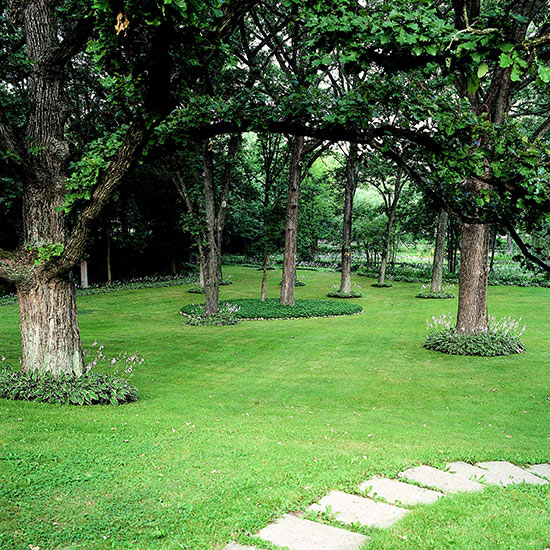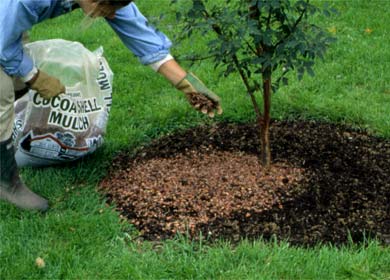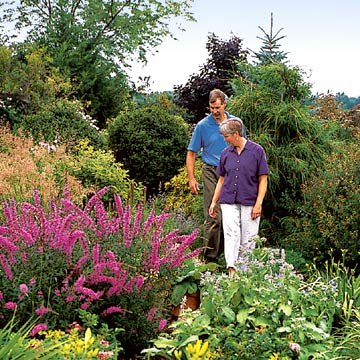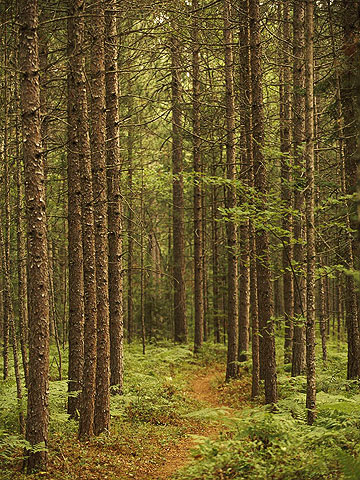





One of the joys of living in the country is being surrounded by big, wonderful trees. Not only do they add shade and beauty, but they also add greatly to the value of your property. Replacing even a small tree can run into the hundreds of dollars. It only makes sense, then, to protect your investment and nurture trees so they can be appreciated for generations. Here are 10 tips to keeping your trees healthy.
continue reading below These trees had to start from somewhere. Follow these tips to ensure your trees will look this great.
These trees had to start from somewhere. Follow these tips to ensure your trees will look this great.
1. Back off. The good news is that, for the most part, trees can fend for themselves. After all, those centuries-old beauties you see dotting the countryside didn't get that way with lots of fussing and primping.
"Generally speaking, the trees don't need us to grow," says Dan Green, owner of Woodland Management, an Oregon tree and woodland care service. But there are things you should do to make sure you have the healthiest trees possible. First, leave them alone. A tree's biggest enemy is, well, you. One of the leading causes of the death of mature trees is harm unwittingly done to them by the owner.
"We are the enemy when it comes to trees," says Jim Skiera, associate executive director of the International Society of Arboriculture.
2. Watch where you dig. Construction is probably the biggest killer of mature trees, Skiera says, especially when heavy equipment is involved. Consider the case of a Missouri couple who designed the driveway of their new house around a glorious 200-year-old tree. They laid the driveway and the tree promptly died.
Even if it seems construction is taking place relatively far away from a tree, remember that a root system can extend two to three times farther than the branches. With a mature tree, that means heavy equipment operating even 60 feet away can compact the soil and damage roots, causing the tree to die in a few months or slowly over a period of years.
So whether you're laying a driveway or building a shed, take a moment to talk about protecting the trees with any contractor and specify where heavy equipment can and can't go. It's best to mark off areas around trees during construction. Stake off areas at least 10 feet from the drip line of the tree, that is, as far as the branches of the tree extend.
3. No parking. Avoid parking vehicles under trees. Over the years, the soil becomes compacted and can slowly kill the tree.
4. Whack carefully. Mowers and weed whackers (power string trimmers) can be tree enemies, nicking the bark and weakening the tree, making an ideal entry point for disease.
Learn the best fast-growing trees to add to your landscape.

5. Mulch regularly. It's important to mulch around the base of your trees (with the exception of trees in a woodland situation). Apply a 1- to 4-inch layer of wood chips or shredded bark, pine needles, shredded autumn leaves, cocoa hulls, straw, or other biodegradable mulch. The mulch should start an inch or two from the trunk of the tree, extending as far as the drip line or at least 3 feet away from the base of the trunk. Not only will mulch protect your tree from lawn equipment, but also it will suppress weeds and keep moisture in the soil.
6. Don't overwater or overfertilize. For the most part, a mature tree needs little assistance when it comes to food and water. While trees planted in the last three or four years benefit from additional fertilizing and watering, large trees can actually be damaged by fertilizer and too much water. They can also be damaged by lawn and garden herbicide applications -- another good reason to lay down that big circle of mulch so you're not pouring chemicals into at least part of the tree's roots.
In the arid West, says Green, new homeowners installing sprinkling systems often unwittingly begin watering trees that are used to dry conditions, soaking the soil and depriving them of the oxygen they're used to. This can lead to sick or even dead trees.
7. Trim back on pruning. Benign neglect is also useful when it comes to pruning. Mature trees seldom need much, other than removing dead or damaged branches and trimming off any suckers that shoot up at the base. Thin, crowded growth on mature branches (especially those of fruit trees), called water sprouts, should be regularly trimmed, as should any rubbing or problem branches.
8. Know your trees and your diseases. Even though your trees don't need much from you, it's a good idea to keep a watchful eye over them. Many diseases are specific only to certain species, so to diagnose the problem you'll first need to know the tree. A good reference book can come to the rescue. Check out the bookstore or your local library for a tree identification booklet. Two excellent plant disease manuals are Ortho's Home Gardener's Problem Solver (Ortho Books, 2001) and Plant Health Care for Woody Ornamentals (University of Illinois Press, 1997). Both books include plenty of photos and help you identify the problem and give sound recommendations on resolving it.

9. Walk your property. Walk your property regularly, and take a close look at your trees. Check leaves and branches for any insects or signs of insect activity, dead twigs, mushrooms growing on or around the base of the tree, and odd spots on leaves.
10. Stand back and enjoy. Few things on your property will give you as much beauty and pleasure for so little labor as your mature trees. As Skiera says, "For the most part, trees do very well if you just leave them alone."

If you have a wooded area to care for, the same less-interference-is-more rule applies. Nature is pretty smart about taking care of itself. Rotting trees feed the woodland floor, attract insects that draw wildlife, and serve as a home for many small mammals. Vines, undergrowth, and other plants you might dismiss as messy-looking weeds also serve an important role in the woodland ecosystem. In fact, in some cases, completely clearing out all the undergrowth of a natural woodland can lead to disease problems.
Keep a lookout for any major disease problems. In a wooded area, a few sick trees can be "akin to an influenza outbreak in an old folks' home," Dan Green says. Disease can spread rapidly, so if several trees are showing signs of the same problem, contact your local Extension Service, state forestry office, or a private consulting forester to get it diagnosed.
It's fine to clear paths for strolling through your wooded area, but be aware that the warmer, moister, and lusher your region, the higher the maintenance of those paths will be. In a moist climate, you may need to clear paths every three or four months. In a high, arid region, a path can last with minimal care for 30 years.
Many property owners want to embellish their woodlands with low-maintenence trees and shrubs. In deciduous woodlands, spring-blooming bulbs, such as daffodils and crocuses, will thrive and usually spread. In areas that get light sun, perennial or reseeding flowers will thrive. Good choices include forget-me-not, hellebores, and woodland phlox. Good flowering shrubs for the lightly shaded areas around the margins of a wooded area include azaleas, rhododendrons, hydrangeas, and viburnums.
Copyright © www.100flowers.win Botanic Garden All Rights Reserved